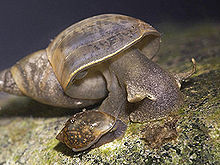Pond snails
| Lymnaeidae | |
|---|---|
 |
|
| Lymnaea stagnalis is the large snail behind the smaller one, Physa sp | |
| Scientific classification | |
| Kingdom: | Animalia |
| Phylum: | Mollusca |
| Class: | Gastropoda |
| (unranked): | clade Heterobranchia clade Euthyneura clade Panpulmonata clade Hygrophila |
| Superfamily: |
Lymnaeoidea Rafinesque, 1815 |
| Family: |
Lymnaeidae Rafinesque, 1815 |
| Diversity | |
| about 100 freshwater species
or less than 100 |
|
or less than 100
or more than 250
Lymnaeidae, common name the pond snails, is a taxonomic family of small to large air-breathing freshwater snails, aquatic pulmonate gastropod mollusks, that belong to the clade Hygrophila.
Lymnaeidae is the only family within the superfamily Lymnaeoidea (according to the taxonomy of the Gastropoda by Bouchet & Rocroi, 2005).
Bouchet & Rocroi (2005) recognized four subfamilies within Lymnaeidae:
Vinarski (2013) established a new subfamily Radicinae within Lymnaeidae, but be considered position neither of Lancinae nor of extinct genera.
Correa et al. (2010) examined phylogenetic relationships among 50 taxa of this family using a supermatrix approach (concatenation of the 16S, internal transcribed spacers ITS1 and ITS2 genes) involving both maximum likelihood and Bayesian inference. Her phylogenetic analysis demonstrates the existence of three deep clades of Lymnaeidae representing the main geographic origin of species (America, Eurasia and the Indo-Pacific region). It demonstrates that the nomenclature of most genera in the Lymnaeidae does not reflect evolutionary relationships.
A cladogram based on sequences of 16S, internal transcribed spacers ITS1 and ITS2 genes showing phylogenic relations of Lymnaeidae by Correa et al. (2010):
...
Wikipedia
